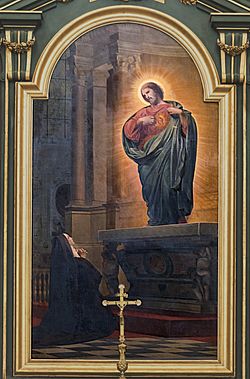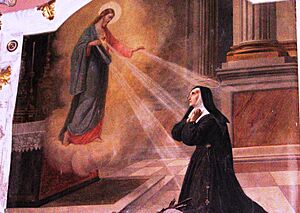Margaret Mary Alacoque facts for kids
Quick facts for kids SaintMargaret Mary Alacoque VHM |
|
|---|---|

Margaretha Maria Alacoque, Montauban Cathedral
|
|
| Virgin | |
| Born | 22 July 1647 L'Hautecour, Duchy of Burgundy, Kingdom of France |
| Died | 17 October 1690 (aged 43) Paray-le-Monial, Duchy of Burgundy, Kingdom of France |
| Venerated in | Roman Catholic Church |
| Beatified | 18 September 1864, Rome by Pope Pius IX |
| Canonized | 13 May 1920, Vatican City by Pope Benedict XV |
| Major shrine | Monastery of the Visitation, Paray-le-Monial, Saône-et-Loire, France |
| Feast | October 16 (October 17 by the Order of the Visitation of Holy Mary and universally prior to 1969; transferred to Oct 20 in Canada) |
| Attributes | Young nun wearing the black Visitandine habit and holding an image of the Sacred Heart |
Saint Margaret Mary Alacoque (born Marguerite-Marie Alacoque) was a French Catholic nun. She lived from 1647 to 1690. Margaret Mary was a mystic who helped spread a special way of praying. This prayer is called the Sacred Heart of Jesus devotion.
Contents
Biography of Margaret Mary
Early Life and Childhood
Margaret Mary Alacoque was born in 1647 in L'Hautecour, France. This area was part of the Duchy of Burgundy. She was one of seven children and the only daughter. Her father was a notary, which means he prepared legal documents.
When Margaret was eight years old, her father passed away. She then went to a convent school run by the Poor Clares. There, she received her First Communion at age nine. After this, she became very sick with rheumatic fever. She was confined to her bed for four years.
Margaret Mary promised the Blessed Virgin Mary that she would become a nun if she got well. It is said that she was instantly healed after making this promise. To show her thanks, she added "Mary" to her name. She later wrote that she had visions of Jesus Christ from a young age. She thought these visions were normal.
Family Struggles and a Special Vision
After her father's death, Margaret's family faced hard times. Her uncle held onto their money and would not release it. This made her family poor. Margaret found comfort by praying often in the local church. She prayed before the Blessed Sacrament.
When she was 17, things got better. Her brother became old enough to take control of their home. Her mother wanted her to find a husband. Margaret started going to social events like dances. She believed her childhood promise was no longer important.
One night, after a party, she had a powerful vision. She saw Jesus, hurt and bleeding. He reminded her of her promise. But He also showed her that His heart was full of love for her. Because of this vision, she decided to keep her vow. She entered the Visitation Convent in Paray-le-Monial in 1671. She was almost 24 years old.
Life as a Nun
Margaret Mary faced many challenges at the convent. These challenges tested if her calling to be a nun was real. She was allowed to wear the nun's habit in August 1671. However, she was not allowed to take her final vows a year later, which was the usual custom.
A fellow nun described Margaret Mary as humble and kind. She was also simple and honest. Finally, she was allowed to take her vows in November 1672. She was assigned to the infirmary, where sick nuns were cared for. It is said she was not very good at these tasks.
Visions of the Sacred Heart
While at the monastery, Margaret Mary said she received several special messages. These were about the Sacred Heart. The first vision happened on December 27, 1673. The last one was 18 months later.
These visions showed her how to practice the devotion. Key parts included receiving Holy Communion on the first Friday of each month. Another part was Eucharistic adoration during a "Holy hour" on Thursdays. The visions also asked for a special celebration called the Feast of the Sacred Heart. Margaret Mary said Jesus asked her to spend an hour each Thursday night. This hour was for thinking about Jesus' suffering in the Garden of Gethsemane. This "Holy Hour" practice later became popular among Catholics.
On December 27, 1673, Margaret Mary said Jesus let her rest her head on His heart. He then told her about His great love. He wanted this love to be known to everyone. He chose her to share this message.
At first, many people did not believe her. She found it hard to convince her superior, Mother de Saumaise. She also could not convince other religious leaders or many nuns in her own community.
In 1675, Margaret Mary reported three special requests from Jesus for France. These requests were for the kings of France.
- The first request was for Jesus to be honored in the homes of princes and kings. He wanted His "adorable Heart" to be received. This would help establish His rule in the heart of the King.
- The second request was to build a place for a painting of the Sacred Heart. Here, the King and his court would honor it.
- The third request was for the Sacred Heart to be painted on the King's flags and engraved on his weapons. This would help him win against his enemies. It would also help him triumph over enemies of the Church.
Around 1681, Margaret Mary wrote a personal promise. She dedicated her life completely to Jesus. She even signed it with her own blood. This showed her deep commitment.
Later, she received support from Claude de la Colombière. He was the community's confessor, a priest who heard confessions. He believed her visions were real. In 1683, the opposition in the community stopped. Mother Melin became the new Superior and made Margaret Mary her assistant. Margaret Mary later became the teacher for new nuns. The monastery began to celebrate the Feast of the Sacred Heart privately in 1686. Two years later, a chapel was built to honor the Sacred Heart. The devotion then spread to other Visitation convents.
In 1689, Margaret Mary received another message. Jesus asked her to urge King Louis XIV of France to dedicate the nation to the Sacred Heart. This would help the King be "triumphant over all the enemies of Holy Church." It is not known if King Louis XIV ever received the letter or if he chose not to respond.
Margaret Mary Alacoque passed away on October 17, 1690.
Veneration and Legacy


After Margaret Mary's death, the devotion to the Sacred Heart grew. The Jesuits especially helped it spread. However, it was still debated within the Catholic Church for many years. The practice was not officially recognized for 75 years.
People continued to discuss Margaret Mary's life and visions. All her actions and teachings were carefully examined. The Church eventually recognized her great virtues. She was given the title "servant of God." In 1824, Pope Leo XII declared her "venerable." Then, in 1864, Pope Pius IX declared her "blessed." When her tomb was opened in 1830, two instant cures were reported. Her body now rests in the Chapel of the Apparitions. This chapel is at the Visitation Monastery in Paray-le-Monial. Many pilgrims visit it from all over the world.
Margaret Mary Alacoque was made a saint by Pope Benedict XV in 1920. Her feast day was added to the Church calendar for October 17. In 1969, the feast day was moved to October 16. In the United States, it is an optional day of remembrance.
In 1928, Pope Pius XI wrote an important letter called Miserentissimus Redemptor. In it, he confirmed that the Catholic Church believed Margaret Mary's visions were real. He wrote that Jesus "manifested Himself" to her. He also promised that those who honored His Heart would receive many heavenly graces.
Margaret Mary's short book, La Devotion au Sacré-Coeur de Jesus, was published after her death. It has been very popular among Catholics.
On the Caribbean island of Saint Lucia, there are two flower festivals. Each festival has a patron saint. For the Roses festival, it is Saint Rose of Lima. For the Marguerites festival, it is Saint Margaret Mary Alacoque. This festival is celebrated on October 17.
In Popular Culture
The detente bala amulet used by Spanish soldiers is said to come from Margaret Mary's symbols.
In James Joyce's short story "Eveline", a "coloured print of the promises made to Blessed Margaret Mary Alacoque" is mentioned. This shows how popular the devotion was in Irish Catholic homes around 1900.
See also
 In Spanish: Margarita María Alacoque para niños
In Spanish: Margarita María Alacoque para niños
- Act of Consecration to the Sacred Heart of Jesus
- First Fridays Devotion


